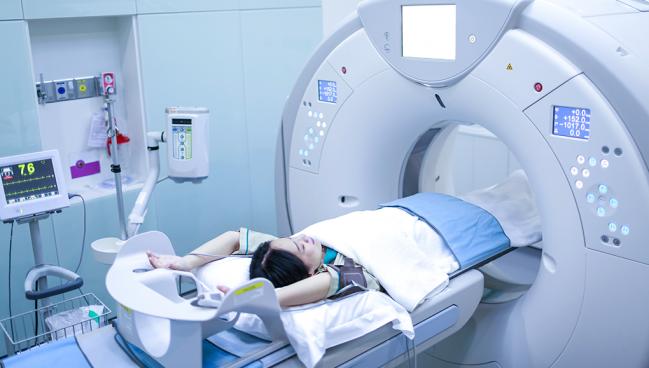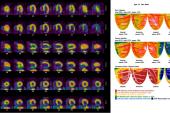Positive Phase III Results Bring Excitement for Novel PET Imaging Tracer
More options are needed to support increasing use of cardiac PET for the detection of CAD, one expert says.

A novel tracer for positron emission tomography (PET) myocardial perfusion imaging, called flurpiridaz F-18, performed well in a second phase III trial when it came to the detection of CAD in patients with suspected disease, with excitement building for its anticipated regulatory approval.
Compared with invasive coronary angiography, flurpiridaz PET significantly outperformed a prespecified 60% threshold for sensitivity and specificity for CAD diagnosis. It also was significantly better than technetium-99m-labeled single-photon emission computed tomography (SPECT) for the detection of CAD overall and in key patient groups, including women and patients with obesity.
Moreover, flurpiridaz PET was well tolerated and came with lower radiation exposure, enhanced image quality, and greater confidence in interpretation of the results, researchers led by Jamshid Maddahi, MD (David Geffen School of Medicine at University of California-Los Angeles), report in a study published online ahead of the October 17, 2023, issue of the Journal of the American College of Cardiology.
This is the second positive phase III trial of the new tracer. The first, which included patients with known or suspected CAD, showed that flurpiridaz PET had higher sensitivity—but failed to establish noninferiority regarding specificity—compared with SPECT. Some of the same secondary benefits with use of the tracer seen in the current study were also seen in the prior one.
To TCTMD, Maddahi said there is a lot of excitement within the nuclear cardiology community about the development of flurpiridaz because it overcomes some of the limitations of currently available tracers, including N-13 ammonia and rubidium-82. Among the major advantages, he noted, is the longer half-life, which means that it can be produced at a regional facility and transported to centers when it’s needed. Centers wouldn’t be required to have on-site cyclotrons or generators, which is a challenge for many hospitals.
Moreover, he said, flurpiridaz can be delivered as a single dose for scheduled studies, making it more economically attractive and reducing concerns about fluctuations in patient volumes.
Because of issues with existing tracers, “cardiac PET has not really taken off, even though all prior research has shown that it is superior to SPECT myocardial perfusion imaging,” Maddahi said, noting that PET accounts for only about 12% of myocardial perfusion imaging studies, with SPECT the rest.
Commenting for TCTMD, Jamieson Bourque, MD (University of Virginia, Charlottesville), who wrote an accompanying editorial, said this trial designed to facilitate the US Food and Drug Administration approval of flurpiridaz for PET imaging is of “critical importance” to the nuclear cardiology field, a community that is “very excited about the prospect of having a new tracer option.”
The results “should pave the way for approval of F-18 flurpiridaz, and this will support the appropriate growth and expansion of cardiac PET,” he said. One particularly important impact of its approval is that it would ease the use of PET for new programs, as well as those in remote locations.
Benefits in Important Patient Subsets
The trial included 730 patients with suspected CAD enrolled at 48 sites across the US, Canada, and Europe. All underwent 1-day rest/stress flurpiridaz PET and 1- or 2-day rest-stress technetium-99m-labeled SPECT before invasive angiography, with images read by three experts who were blinded to clinical and angiographic data. Pharmacological stress was used for testing in 83% of patients, with treadmill testing employed in the rest. Ultimately, 578 patients (mean age 63.7 years; 32.5% women) were able to be evaluated for the analysis.
The primary efficacy endpoints were the sensitivity and specificity of flurpiridaz PET for the detection of CAD (≥ 50% stenosis), with a prespecified threshold of 60%—as agreed to by the FDA—that needed to be exceeded for at least two of the three readers. For two of the readers, sensitivity (77.1% and 73.5%) and specificity (65.7% and 69.6%) were significantly above 60%. For the third, sensitivity (88.8%) met the goal, but specificity did not (52.6%).
Comparison with SPECT was a secondary endpoint, and flurpiridaz PET proved to have superior sensitivity (80.3% vs 68.7%; P = 0.003) and noninferior specificity (63.8% vs 61.7%; P = 0.0004).
Flurpiridaz PET showed superior discrimination for CAD compared with SPECT, with a higher area under the receiver-operating characteristic curves in the overall trial population (0.80 vs 0.68; P < 0.0001), in women (0.84 vs 0.70; P = 0.0091), and in patients with obesity (0.79 vs 0.67; P = 0.0008). A similar trend in patients with diabetes did not reach statistical significance (0.76 vs 0.69; P = 0.0887).
Other endpoints, including the evaluation of perfusion defect size and severity, image quality, diagnostic certainty, and radiation exposure also significantly favored flurpiridaz PET over SPECT.
Use of the novel tracer was “safe and well tolerated,” the researchers report, who note that there were no changes in laboratory parameters that were reported as adverse events and no clinically relevant ECG changes after flurpiridaz injection.
Unique Benefits
Compared with the other tracers, flurpiridaz has superior spatial resolution and more-precise measurement of myocardial blood flow for the assessment of microvascular disease, said Bourque. And with a half-life of 110 minutes, it can be routinely used in exercise stress testing.
“Exercise capacity is the most-powerful prognostic marker available in assessment of ischemic heart disease, and this is the only PET tracer that really supports exercise stress,” he said.
With two phase III trials, there are now enough data to support FDA approval of flurpiridaz, Bourque predicted. Once that happens, the use of cardiac PET can grow. One potential obstacle to that would be “if the tracer is prohibitively expensive,” he said. However, for centers with lower volumes of patients, it’s thought that “the unit dosing is going to be financially more beneficial,” Bourque continued, because centers can order what they need rather than spending money on generating tracers that won’t get used.
With respect to cost, Maddahi believes unit dosing will allow new programs and those with lower testing volumes to incorporate PET imaging in a more-economical fashion. This particular aspect will be more important outside of the US where there are even fewer PET scans being performed, he added.
One issue with flurpiridaz PET is that there is a bit of a learning curve for interpretation, because the image quality is so much better than what is achieved with other tracers, Maddahi said. “Image quality is much, much better, confidence of interpretation is much higher, and also quantitation of myocardial blood flow is optimal with this tracer,” he said. But that also means that physicians have to learn how to appropriately interpret the findings from the enhanced images.
Todd Neale is the Associate News Editor for TCTMD and a Senior Medical Journalist. He got his start in journalism at …
Read Full BioSources
Maddahi J, Agostini D, Bateman TM, et al. Flurpiridaz F-18 PET myocardial perfusion imaging in patients with suspected coronary artery disease. J Am Coll Cardiol. 2023;82(16):1598-1610.
Bourque JM. Cardiac PET perfusion imaging: AURORA lights the way to a new era. J Am Coll Cardiol. 2023;82(16):1611-1613.
Disclosures
- The study was funded by GE Healthcare Ltd and its affiliates, Chalfont St Giles, United Kingdom.
- Maddahi reports having served as a consultant to and received a research grant from GE Healthcare Ltd and its affiliates.
- Bourque reports having served on a GE Healthcare advisory board for amyloid imaging.





Comments